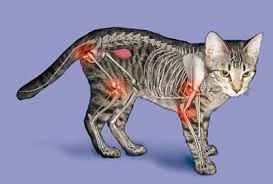- understanding-arthritis-in-pets
- common-signs-of-arthritis-in-older-cats
- common-signs-of-arthritis-in-older-dogs
- managing-arthritis-in-older-pets
- real-life-examples
1. Understanding Arthritis in Pets
Arthritis is a common issue for senior cats and dogs, and it can greatly affect their mobility and quality of life. It’s a degenerative joint disease that results in inflammation, pain, and stiffness in the joints, making it difficult for your pet to move around comfortably. As pets age, their bodies experience wear and tear, which can lead to the breakdown of cartilage and the development of arthritis.
Arthritis can affect any pet, but it’s more common in older cats and dogs due to the natural aging process. It can occur in one or multiple joints and may worsen over time if not addressed. Recognizing the early signs of arthritis is crucial for providing timely relief and improving your pet's comfort.
2. Common Signs of Arthritis in Older Cats
Cats are experts at hiding pain, so arthritis in felines can sometimes go unnoticed until it has significantly impacted their well-being. However, with a little attention to their behavior, you can identify signs of arthritis in older cats.
2.1 Difficulty Jumping or Climbing
One of the earliest signs of arthritis in older cats is difficulty with activities that require jumping or climbing, such as reaching the top of a cat tree or getting onto a bed. Cats with arthritis often avoid these activities because it causes them pain. If you notice your cat hesitating to jump or struggling with these tasks, it could be a sign of joint discomfort.
2.2 Decreased Activity Level
Older cats with arthritis may be less active than they once were. They might sleep more or show disinterest in playing or exploring. While cats are generally known for their independent nature, a significant reduction in activity could indicate arthritis or joint pain.
2.3 Changes in Grooming Behavior
Arthritis can make grooming painful for cats, particularly when they need to reach their back or lower areas. As a result, they may stop grooming as thoroughly, leading to a dull or matted coat. If you notice a decline in grooming behavior, arthritis could be the cause.
2.4 Signs of Pain or Irritability
Arthritic cats may become more irritable or aggressive due to the pain they experience. If your cat is usually gentle but has started hissing, swatting, or becoming unusually sensitive to touch, it could be a sign that they are in pain from arthritis.
3. Common Signs of Arthritis in Older Dogs
Just like cats, dogs also experience arthritis as they age. However, dogs tend to show more visible signs of discomfort. Identifying these symptoms early can help improve their quality of life and prevent further damage to their joints.
3.1 Limping or Lameness
Limping or lameness in one or more legs is a classic sign of arthritis in older dogs. They may limp after getting up from a nap or after short walks. The limp may become more noticeable in colder weather, as the joints tend to stiffen up in the cold.
3.2 Difficulty with Stairs and Ramps
If your dog has trouble navigating stairs or ramps, it could be a sign that they are dealing with joint pain. Many dogs with arthritis will try to avoid stairs or struggle to go up or down them. This behavior change is especially noticeable if your dog used to enjoy these activities without issue.
3.3 Decreased Mobility and Stiffness
Arthritis often leads to stiffness in older dogs. You might notice that your dog moves more slowly, hesitates to get up after lying down, or appears stiff when walking. In severe cases, the dog may have trouble standing or walking for long periods of time.
3.4 Behavioral Changes and Aggression
Similar to cats, dogs with arthritis may show increased irritability or aggression. If a dog that was once calm becomes more anxious or reactive, it could be because of the discomfort caused by arthritis. They may also resist being touched, particularly around the areas where they experience joint pain.
4. Managing Arthritis in Older Pets
If you suspect that your pet is suffering from arthritis, it’s important to consult your veterinarian for a proper diagnosis and treatment plan. Managing arthritis involves a combination of lifestyle changes, medical treatments, and natural remedies to alleviate pain and improve mobility.
4.1 Medication and Pain Relief
Many pets with arthritis benefit from anti-inflammatory medications or pain relievers prescribed by a vet. These medications help reduce inflammation and ease pain, making it easier for your pet to move. Your vet may also recommend joint supplements containing glucosamine, chondroitin, or omega-3 fatty acids to support joint health.
4.2 Weight Management
Maintaining a healthy weight is crucial for pets with arthritis. Excess weight puts additional strain on their joints, exacerbating the pain. Regular exercise and a balanced diet can help manage their weight and reduce the impact of arthritis on their mobility.
4.3 Joint Support and Mobility Aids
For pets with severe arthritis, mobility aids such as ramps, orthopedic beds, or joint support braces can make a significant difference. These aids help reduce strain on affected joints and provide your pet with greater comfort during daily activities.
4.4 Home Modifications
Small changes in your home can make it easier for your pet to get around. Consider providing soft, comfortable bedding to ease joint pain, and ensure that they have easy access to food and water. Avoiding slippery floors and providing gentle, low-impact exercises can help keep your pet’s joints mobile.
5. Real-Life Examples
Meet Charlie, a 12-year-old Labrador Retriever who had become increasingly stiff and struggled to walk after his morning nap. His owner, Laura, noticed that Charlie had trouble getting up after resting and was reluctant to go on walks. After visiting their vet, Charlie was diagnosed with arthritis. Laura started giving him glucosamine supplements and pain medication, along with modifying his diet to help with weight management. With these changes, Charlie has regained much of his mobility and is now able to enjoy daily walks again.
Similarly, Bella, a 10-year-old cat, had been hiding more often and avoiding her favorite climbing spots. Her owner, Sarah, noticed that Bella’s once-sleek coat had become matted and she wasn’t grooming herself as much. After a vet visit and arthritis diagnosis, Sarah started incorporating joint supplements into Bella's diet and provided a heated bed to ease her discomfort. Bella is now much more active and happy, playing with her toys again and grooming regularly.












